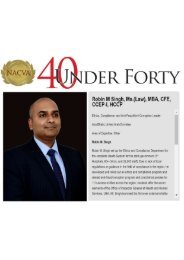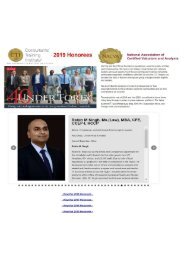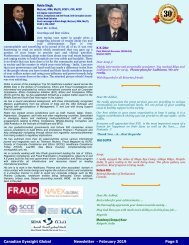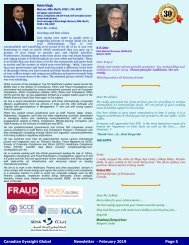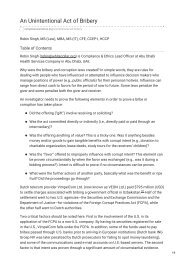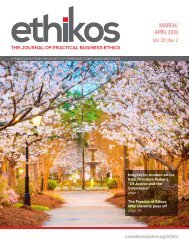Anti-bribery programs: A web of ethical and legal dilemmas
The role of the #iso37001 in curbing the #corruption and safeguarding organizations from #legal exposure with #robinsingh and #SCCE (Society of Corporate Compliance and Ethics)See Less by #RobinSingh the #whitecollarinvestigator
The role of the #iso37001 in curbing the #corruption and safeguarding organizations from #legal exposure with #robinsingh and #SCCE (Society of Corporate Compliance and Ethics)See Less by #RobinSingh the #whitecollarinvestigator
You also want an ePaper? Increase the reach of your titles
YUMPU automatically turns print PDFs into web optimized ePapers that Google loves.
Compliance & Ethics Pr<strong>of</strong>essional ® June 2017<br />
Organization for St<strong>and</strong>ardization (ISO) has<br />
come up with the ISO 37001 st<strong>and</strong>ard. 3<br />
Comprised <strong>of</strong> the national st<strong>and</strong>ards<br />
bodies <strong>of</strong> its 163 member countries, the<br />
ISO develops <strong>and</strong> publishes international<br />
st<strong>and</strong>ards. To date, the ISO has developed<br />
some 20,000 voluntary international st<strong>and</strong>ards<br />
on a vast range <strong>of</strong> different topics. Its aim is to<br />
help organizations establish, implement, <strong>and</strong><br />
maintain an anti-<strong>bribery</strong> compliance program<br />
drawing on global anticorruption<br />
best practice.<br />
A new st<strong>and</strong>ard for<br />
compliance <strong>programs</strong><br />
The primary aim <strong>of</strong> ISO<br />
37001 <strong>and</strong> other anti<strong>bribery</strong><br />
frameworks is<br />
to help organizations<br />
establish an anti-<strong>bribery</strong><br />
management system<br />
to prevent <strong>bribery</strong> by<br />
the organization itself,<br />
by organizations within its supply chain,<br />
or by its staff or personnel. The <strong>bribery</strong> the<br />
st<strong>and</strong>ard seeks to prevent could be either for<br />
the organization’s benefit or in relation to<br />
its activities. The ISO st<strong>and</strong>ard itself is quite<br />
flexible <strong>and</strong> can adapt to a range <strong>of</strong> different<br />
organization types <strong>and</strong> sizes. This includes<br />
large organizations, small- <strong>and</strong> medium-sized<br />
enterprises (SMEs), public <strong>and</strong> privatesector<br />
organizations, <strong>and</strong> non-governmental<br />
organizations (NGOs).<br />
The ISO st<strong>and</strong>ard is designed to be used<br />
by any organization in any country, because<br />
it aims to strengthen an organization’s<br />
approach to compliance by improving policies,<br />
procedures, <strong>and</strong> controls. It emphasizes<br />
business operations, makes use <strong>of</strong> a risk-based<br />
approach, <strong>and</strong> outlines various m<strong>and</strong>ated<br />
procedures <strong>and</strong> controls. Subsequently, it<br />
helps organizations to better respond to <strong>and</strong><br />
underst<strong>and</strong> their operating context with<br />
Comprised <strong>of</strong> the<br />
national st<strong>and</strong>ards<br />
bodies <strong>of</strong> its 163 member<br />
countries, the ISO<br />
develops <strong>and</strong> publishes<br />
international st<strong>and</strong>ards.<br />
strong internal mechanisms, regardless<br />
<strong>of</strong> what the specifics <strong>of</strong> that context might<br />
be. This lends the st<strong>and</strong>ard both flexibility<br />
<strong>and</strong> versatility.<br />
The fact that the st<strong>and</strong>ard can theoretically<br />
be implemented in any context is a key<br />
advantage because, in today’s globalized<br />
economy, companies commonly have<br />
operations spread out across the globe in<br />
different jurisdictions. Adopting the st<strong>and</strong>ard<br />
at an organizational<br />
level facilitates uniform<br />
compliance, no matter<br />
the jurisdictions in<br />
which a company<br />
operates.<br />
To prevent <strong>bribery</strong>,<br />
the ISO st<strong>and</strong>ard<br />
m<strong>and</strong>ates a number<br />
<strong>of</strong> different controls,<br />
st<strong>and</strong>ards, <strong>and</strong><br />
procedures. These<br />
include:<br />
· A clear anti-<strong>bribery</strong> policy, along with<br />
procedures <strong>and</strong> controls in support <strong>of</strong><br />
that policy;<br />
· Top management <strong>and</strong> leadership<br />
commitment to <strong>and</strong> responsibility for<br />
enforcing the st<strong>and</strong>ard;<br />
· Senior-level oversight;<br />
· <strong>Anti</strong>-<strong>bribery</strong> training for management,<br />
staff, <strong>and</strong> personnel;<br />
· Risk assessments;<br />
· Due diligence on projects <strong>and</strong> business<br />
associates;<br />
· Reporting, monitoring, investigation, <strong>and</strong><br />
review; <strong>and</strong><br />
· Corrective action <strong>and</strong> continual<br />
improvement.<br />
However, although the ISO st<strong>and</strong>ard<br />
does <strong>of</strong>fer guidance to help organizations<br />
fully underst<strong>and</strong> the concept <strong>of</strong> <strong>bribery</strong>, it<br />
does not provide an independent definition<br />
62 www.corporatecompliance.org +1 952 933 4977 or 888 277 4977







